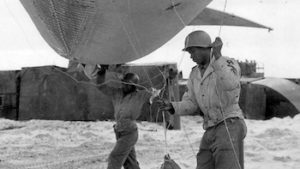
Omaha Beach, 1944
*On this date in 1944, the Normandy landing operations commenced. D-Day was the Allied invasion of Normandy, France, in Operation Overlord during World War II. This was the largest seaborne invasion in modern history and began the liberation of German-occupied northwestern Europe from Nazi control and contributed to the Allied victory on the Western Front.
The 320th VLA (Very Low Altitude) battalion was raised in 1942, just a year after the Coastal Artillery Corps took over responsibility for barrage balloons from the Army Air Corps. There were 39 black anti-aircraft battalions deployed during World War II. Many manned mobile and semi-mobile automatic weapons were deployed to defend various units. But the 320th holds the distinction of being the only all-Black balloon battalion.
There were many heroic stories and episodes during World War II. One was the all-black unit, the 320th VLA Barrage Balloon Battalion. "The 320th VLA was the only black combat unit to participate in the D-Day landings and was the only barrage balloon battalion to land on the beaches. Because the American Army was segregated, the Soldiers of the 320th VLA were all Black.
Units from the 320th landed on both Omaha and Utah beaches at 9 a.m., two hours after the invasion began. The first balloon was floated at 11:15 p.m. that night, and by the next day, all of their balloons were knocked out by German artillery fire. But they were resupplied and were able to float new balloons quickly. The 320th had five batteries and a headquarters battery, with around 700 Soldiers. It took them so long to deploy their balloons because of intense beach fighting. As infantry units solidified their lines, the 320th Soldiers established their positions. Because putting up a balloon on the beach gave German artillery observers something to sight in, they didn't float balloons until the night of June 6.
Soldiers of the 320th VLA also devised an ingenious solution to one problem they had during the landing. The standard winch for the balloons was an M-1 motorized unit that weighed half a ton; many feared they would sink to the bottom of the channel as they were brought ashore from the landing crafts. So, the Soldiers refitted RL-31 Signal Corps field cable winches with barrage balloon reels. The RL-31 only weighed 35 pounds and was mounted in the back of a jeep to deploy and control balloons on D-Day. They flew at an altitude of around 200 feet to defend Soldiers landing on the beaches against strafing attacks by German aircraft. The 320th stayed on Omaha and Utah beaches, providing low-altitude defense. Omaha Beach was one of the major points where supplies continued to come onto the European continent until other ports were secured. By September 1944, Antwerp, Belgium, was secured, and Omaha was too far behind the lines.
Barrage balloons became a liability as Allied forces pushed inland and took control of the countryside. VLA units were slow and cumbersome, and to deploy them, units had to have hydrogen-generating trucks, tank trucks, and various equipment to maintain the balloons. By the end of October 1944, the 320th VLA Battalion was returning to Camp Stewart, Ga., to train for service in the Pacific Theater. They eventually made it as far as Hawaii before the war came to an end.
Overall, some 2,000 Black troops hit Omaha and Utah beaches in Normandy, actively participating in the D-Day invasion. The African American history of this era of American military history shows that Blacks were discouraged from enlisting in the first place; they found the military was no refuge from racism. Banned altogether from the Marines and Air Force, confined to jobs as longshoremen and cooks in the Navy. The only branch that Blacks could join was the Army’s combat unit. But their life there was an endless stream of humiliations, from being herded to the back of military buses on U.S. bases to being refused food by white units on the beach in Normandy.
For some Black soldiers, the worst moment was returning to the United States, where their war sacrifices meant nothing. One recalls getting off the ship from France to discover he wasn't allowed inside stores on military bases. German prisoners were allowed in the PX; blacks couldn't go in the PX. White Southerners were frequently put in charge of Black troops on the theory that they knew how to control them. Within three years after the Normandy invasion, the U.S. military would desegregate. Soon after, "Brown v. Board of Education" touched off the first sparks of the 20th-century American Civil Rights movement.
The Army’s ADA Museum
1506 Bateman Road
Fort Still, OK.,
580-442-0424
Miami Herald, By Glenn Garvin, February 23, 2007